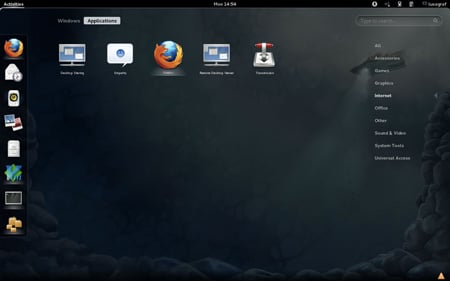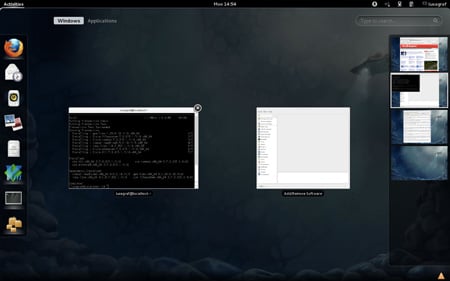Original URL: https://www.theregister.com/2011/11/17/fedora_16_review/
Fedora 16: A GNOME lover's paradise
Verne triumphs over rough edges
Posted in OSes, 17th November 2011 09:40 GMT
Review After several delays, Fedora 16 has been delivered. While hold-ups are a characteristic of the distro's release cycle, these latest ditherings have put the latest version of Fedora a few weeks behind its main competitor, Ubuntu.
Fortunately for Fedora fans this release is well worth the extended waiting time, offering an updated GNOME Shell, the Linux 3.0 kernel and plenty of the under-the-hood improvements that Fedora is known for.
Dubbed Verne and sporting desktop artwork reminiscent of Jules Verne's 20,000 Leagues Under the Sea, Fedora 16 continues the role Fedora took on earlier this year as the central showpiece for the GNOME 3.0 desktop.
While other major distros such as openSUSE - version 12.1 of which was delivered on Wednesday - have also released GNOME 3 builds, Fedora remains one of the most popular ways to stick a toe in the GNOME 3 waters: extra effort has gone into making Fedora's basic theme and the OS's overall look fit in with GNOME 3. As such perhaps the most notable part of Fedora 16 is the upgrade to GNOME 3.2.

Fedora's love-in with GNOME 3 continues
This marks the second incremental update for GNOME but for Fedora users who haven't stayed up to date, Fedora 16 will likely mean leapfrogging straight from GNOME 3 to 3.2.
The good news for those having a little trouble adjusting to GNOME 3, there will be no major changes coming in the next few GNOME releases. Instead, the GNOME team has been focusing on polishing and improving the foundations of GNOME 3 and the improvements show in Fedora 16.
Among the nice improvements in this version of GNOME is the new integrated chat and messaging system that's built into version 3.2. The features mean you can automatically log into your chat and messaging accounts without needing to launch a separate application. That is, you can chat and message right from the GNOME Shell.
The chat and messaging tools also bring a new set of notification windows complete with options to, for example, reply to messages, accept file transfers or even take calls, all from the GNOME shell.
Also high on the list of GNOME 3.2's goals is relieving some of the pain early adopters have suffered through for the last six months. To that end, GNOME 3.2 offers a much improved workspace switcher that has a more permanent display when you're in overview mode. In other words, you can now actually get to the workspace switcher on the right side of the screen when you need it.
Version 3.2 offers status bar notifications for external storage devices with options for mounting, browsing files or ejecting, all displayed at the bottom of the screen whenever you plug in a new device.
GNOME 3's status bar messages have also been improved with a new option to display a counter, for example, to show the number of unread emails or new chat messages.
Perhaps more useful for those who would like to get real work done in GNOME 3 is the new "do not disturb" toggle switch in the user menu. While all the functionality of do-not-disturb mode is actually part of GNOME 3.0, there's no easy way to turn it on. Version 3.2 adds a switch in the user menu and, when enabled, do-not-disturb mode will set your messaging status to busy and stop the endless stream of notifications.
Minor annoyances
For those accustomed to GNOME 2.x, GNOME 3 is still a long way from comfortable. But, like KDE struggling from version 3 to 4 before it, the GNOME team is slowly putting the bugs to rest and adding back the missing features.
Which, of course, does not mean that GNOME 3.2 is perfect. In fact there were enough little bugs and annoyances in my testing - including a particularly annoying inability to automatically detect my screen size and keep it set between reboots - that leaves it feeling rough around the edges and consequently gives the impression that Fedora is less stable than usual.

Workspace switcher has been improved
Fedora 16 ships with a number of updates for the standard GNOME app suite including the Evolution email client - Fedora having decided to stick with Evolution rather than following Ubuntu over to Mozilla's Thunderbird - the Empathy chat app, Rhythmbox and others.
Missing from the live CD are office applications, such as the new LibreOffice which is available via the repos but is no longer installed. The absence of weighty apps minimises the live CD download size. Also not on the live CD, but new in Fedora 16, is the latest version of Blender, a 3D imaging tool.
Fedora 16 also features the latest Firefox release and the usual developer tool updates for Perl, Python and Haskell.
This release also quietly adds support for the fast-growing OpenStack cloud platform, which seems to have gone from unknown to must-have in record time, even for a cloud tool. Ubuntu's 11.10 server already ships with OpenStack, SUSE Linux plans to release a commercially supported version and, presumably as a testbed for an eventual Red Hat Linux release, Fedora 16 includes the Diablo flavour of OpenStack.
Fedora 16 also features the new Linux 3.0 kernel with support for more hardware and improvements to Linux's Btrfs support. Early in the Fedora 16 release cycle there was talk of moving to the Btrfs filesystem as the default for Fedora 16, but in the end it didn't happen. Fedora 16 still defaults to the ext4 filesystem. There is, however, support for the GRUB2 bootloader on x86 systems, which replaces GRUB legacy.
Also worth noting - if only for the name - the HAL daemon, a system process used for accessing hardware and something of a resource hog, has been removed.
Like Ubuntu 11.10, which was released a few weeks ago, Fedora 16 will be making the leap to GNOME 3 not just for the Shell, but for all the underlying system tools as well. That means there will be no way to boot Fedora 16 into GNOME 2.x. There is a simplified "fallback" mode for hardware that doesn't measure up to GNOME 3's requirements, but effectively from here on out, GNOME 3 is GNOME.
If you're less keen on GNOME 3, there are other Fedora spins worth checking out. Both the KDE and Xfce flavours offer most of the same improvements under the hood, and Fedora 16's KDE spin offers the KDE Plasma Workspace 4.7, including both the usual Plasma Desktop and the newer netbook workspace.
For those who've already made peace with GNOME 3, or even enjoy it, Fedora 16 offers one of best platforms on which to run the new Shell environment. Not only is the default theme nicely integrated into GNOME 3, the underlying core has all the usual power of a Fedora release. ®